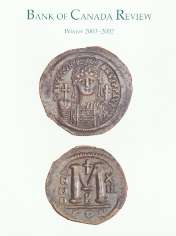Winter 2001–2002

|
The Resolution of International Financial Crises: Private Finance and Public Funds by Andy Haldane, Bank of England and Mark Kruger, Bank of Canada
The Canadian Fixed-Income Market: Recent Developments and Outlook
Risk Management in the Exchange Fund Account
See also: Tables A1, A2, and Notes to the Tables |
Cover: Byzantine 40-Nummi Piece
The coins of the early Byzantine Empire illustrate that period's move away from the artistic conventions of ancient Rome towards a more medieval style. The 40-nummi piece of the Emperor Justinian shown on the cover is an early example of this trend. Justinian ascended to the throne in AD 527. His first issue of copper coins resembled those of his immediate predecessors, who had introduced a standardized group of denominations ranging from 5 to 40 nummi. The design on the reverse of each coin featured a large Greek letter, indicating the denomination, surrounded by stars, pellets, crosses, or crescent moons, all above the abbreviated name of the mint. In the Roman tradition, the obverse featured a profile bust of the emperor and a legend giving his name and titles.
In the twelfth year of Justinian's reign, the copper coinage was modified, resulting in a design that was used even by several of Justinian's successors. The profile bust was replaced by a facing bust of the emperor in military garb holding a globe surmounted by a cross—a globus cruciger. This early Christian symbol showed that the emperor was God's chosen representative, appointed to rule as his regent on earth. The facing bust and the emphasis on Christian symbolism eventually became the norm throughout Europe. Justinian also introduced regnal dates as a means of dating copper coins struck throughout the empire. For example, the coin on the cover was struck "in year 13" (ANNO XIII) of Justinian's reign or AD 539–40.
The 40-nummi piece was the largest and heaviest copper coin minted under Justinian. About the size of an old Canadian silver dollar, it weighs 22.76 grams. It was struck in Constantinople (now Istanbul), the capital of the Byzantine Empire and is part of the National Currency Collection, Bank of Canada.
Photography by James Zagon, Ottawa.




